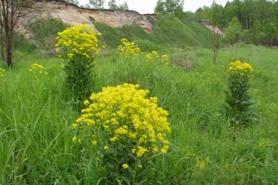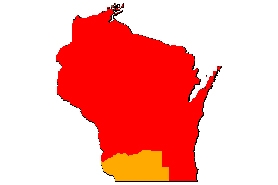Hill mustard
(Bunias orientalis)
An herbaceous biennial that can act like a perennial in Wisconsin. Grows to be 1-4’ tall with warty bumps along the stem and hairs on the stem and leaves.
Other names for this plant include:
- Common names: Turkish warty cabbage, Turkish rocket
Classification in Wisconsin: Prohibited/Restricted (Restricted in Dane, Grant, Green, Iowa, Lafayette, and Rock counties; Prohibited elsewhere).
- Ecological Threat
-
- It invades grasslands, fields, pastures, roadsides and disturbed areas.
- Capable of invading high-quality areas and creating monoculture stands.
- Plants may contain allelopathic compounds (chemicals toxic to surrounding vegetation).
- Identification
-
Leaves: Look similar to dandelion leaves; highly lobed, lance-shaped and covered with hairs. Leaves sometimes have a warty texture as well. Basal leaves can be 12” or longer and get smaller as they move up the stem.
Flowers: Dense clusters of 4-petaled, yellow, fragrant flowers. Blooms in late spring. Flowers are self-fertile and hermaphroditic (containing both male and female organs).
Fruits & seeds: Oval or tear-shaped fruits are covered with warty bumps and contain 2-4 seeds.
Roots: Taproot at least 1” wide, generally in a cluster of roots. Extremely hard to pull or dig roots out.
Similar species: Hill mustard resembles yellow rocket (Barbarea vulgaris; non-native) but is easily distinguished by its stem texture and fruit. Yellow rocket is shorter, their stems do not have warty bumps and their fruits have narrow seed pods.
- Control
-
Mechanical: Use tillage to dislodge the root system. When flowers appear, mow as close to the ground as possible to halt seed production. Continual mowing regimes may be needed as cutting once may result in more excellent seed production.
Chemical: Foliar spray with 2,4-D or metsulfuron before seed set.
For more information on control techniques, visit the Hill Mustard factsheet [exit DNR] by the University of Wisconsin-Extension.
- Resources
- Sources for content:
- Panke, Brendon, Ryan deRegnier and Mark Renz. Management of Invasive Plants in Wisconsin, Hill Mustard Factsheet. UW-Madison Extension.


